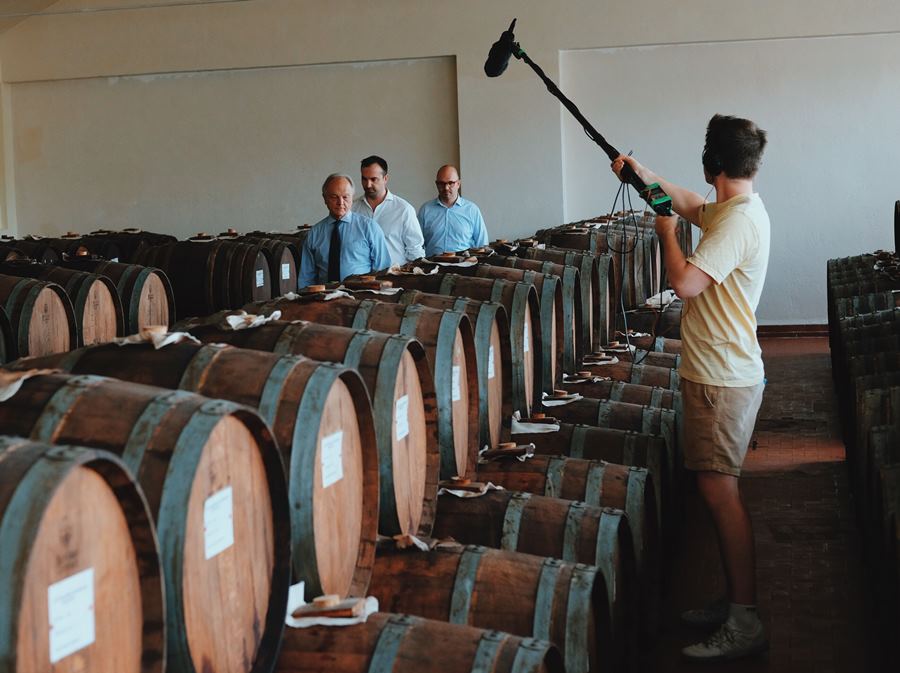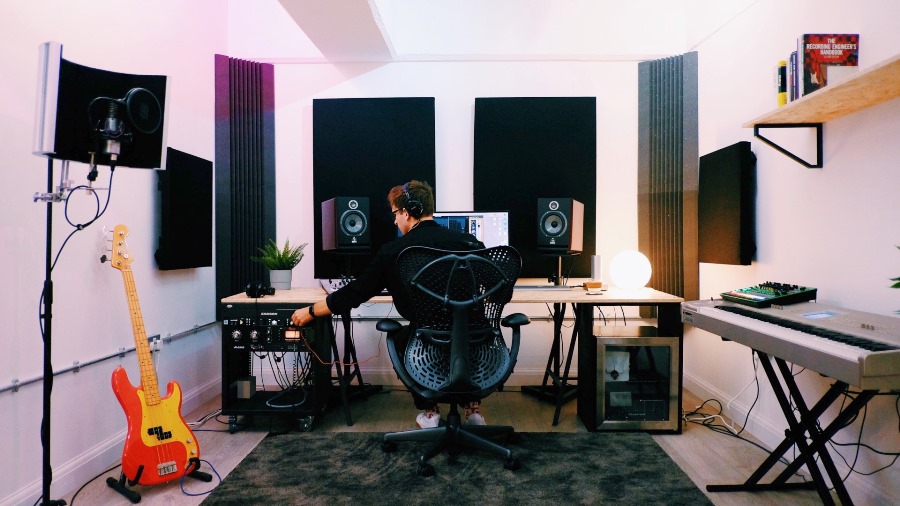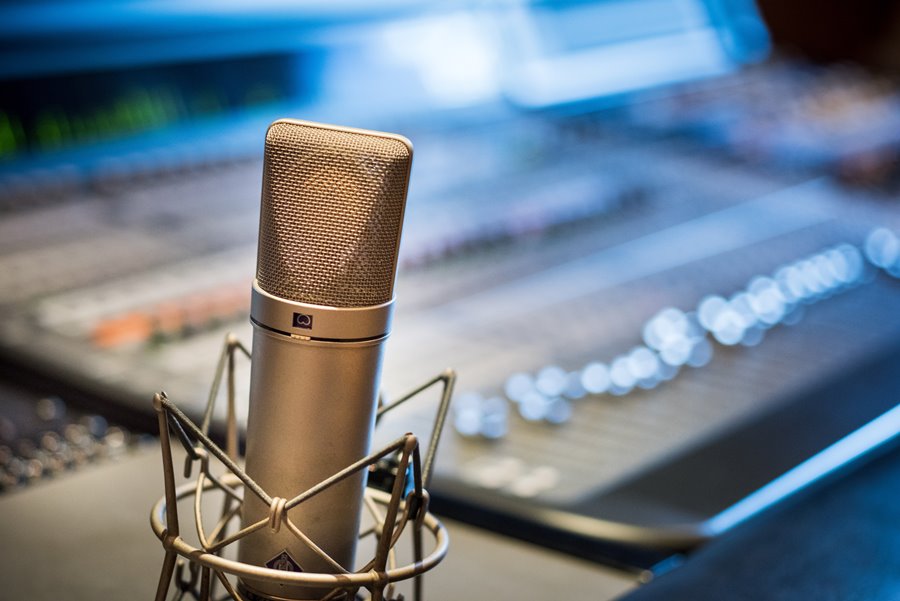Are you giving audio the attention it deserves? Hugo Ellingham explains why audio is just as vital as visual

A bit of context: I’m one of four who run Brother Film Co., a production company focused on making branded content and creating it all in-house (or as much as possible). What makes us slightly different from the rest is that our in-house process includes a full music and sound studio, dedicated to producing soundtracks, recording voiceovers and creating sound design for all our projects.
Today, I’m going to share with you the way we approach sound for film. Audio is treated on an equal level to visual in our workflow, and this article will try to cover all the bases that go into creating the audio for a piece of visual content: the music, sound design and voiceovers/interviews. I’ll touch on hardware, software, and the tips and techniques you can use to add those extra dimensions to your films.
Shameless plug number one: If you want to find out a bit more about us, here’s a handy little film to explain!
The power of audio
Music and sound can transform a film in a really powerful way. Often a piece of visual content can completely alter the emotion that it carries, simply through changing the song or the sound design, so fully embracing and maximising the potential of this tool can elevate your production to the next level. It’s funny to think that you can happily listen to a radio drama without visuals, but you’d rarely (if ever) watch a TV drama on mute. Alternatively, have you ever watched a scary film with the volume way down? All of a sudden, not so scary…
As the importance of short, sharp video content increases for brands, events and social campaigns, we think the audio side of this marketing should be treated as equally important. The sound design and soundtrack can often get overlooked in branded work. This is sometimes due to budgets and sometimes due to a large percentage of the audience watching an Instagram ad with their phone on mute. But with social content quickly taking over the reins from TV ads, having high production in every aspect of your work can ultimately increase its shareability.
Whether it’s a conscious decision to only use a soundtrack and no sound design, it’s also a decision to let the tone of the music dictate the emotion of the video. Similarly, if a conscious decision is made to purely use sound design and no soundtrack, this will add a huge amount of meaning and emphasis to the actions that are treated with audio.
Finding the right soundtrack
First up, soundtracks: Finding the right music for your film can be a daunting and time-consuming challenge. There are more production music libraries than ever on the web. They all promise to offer amazing music for cheaper and cheaper prices, and often fall short at first glance. That being said, most of these sites offer a free service.
Email over a reference or some key instruments, emotional responses or styles, and they’ll send you some good options to test out for yourself. It’s really very useful to take advantage of this service and can yield music options far greater than what you might stumble across when trawling through a library for a couple of hours.
We’ve found that PremiumBeat offers some great soundtracks and has a huge variety of options. Recently, we’ve also chatted to a lot of freelancers and production companies who’ve all started using Artlist, a new library with a seemingly impossibly cheap price point of $16.60 per month for unlimited downloads. The reviews from people I’ve chatted to recently have all been really good, and it’s definitely cheap enough to try out. Generally, I’d recommend trying out a number of different libraries to gauge the quality and relevance of their music options, before making any commitments.
Whether you choose to subscribe to your favourite library or purchase each track as you go will really depend on how you work or run your business. From my experience, production companies tend to have a number of subscriptions to big libraries and charge their clients a fixed fee (per project) for the music. However, individual freelancers and directors often don’t want to, or don’t have the money to pay for ongoing subscriptions, and prefer to purchase tracks as and when they need them – passing the cost directly to the client for each project.
Subscription models will obviously result in cheaper soundtracks over the course of a year. They really are worth it if you’re creating multiple videos, and are happy with the process of using a library and the quality of its tracks. The downside can come when you can’t find what you’re looking for in the library you’ve subscribed to and end up going somewhere else instead.
This train of thought moves very smoothly to shameless plug number two: A recent development of our own business is that we’ve created our own soundtrack library! Having spent four years creating a library of bespoke music for a lot of our own projects, we’ve now opened it up to directors, filmmakers, production companies and anyone else who wants to use it.
With just over 100 soundtrack options (and counting), our library is small enough that you can easily browse your way through it, but large enough to include both variety and options. We like to think of it as a big bag of songs we wish we always had access to. It’s a collection of music we’re really proud of, and you can browse and license tracks right now. It’s music made for film, by filmmakers.

Understanding sound design
Sound design has two distinct styles, natural and conceptual, both of which add texture to a video. Natural can either come from on-set recordings or additional sound design in post. It recreates the expected sound that comes from the visuals you are watching, whether that be brushing past a plant or eating a crisp.
Conceptual comes from a sound that’s added to something visual that has no common, relatable sound, but continues to add meaning and depth to the piece that you’re watching. This could be the swooping sound of a title that fades in or a transition in the video, accompanied by a swish.
Sound effects and sound design can be achieved by either recording your own, original effects – smartphones can produce surprisingly crisp audio recordings if you don’t have any dedicated equipment – or audio sharing sites. Freesound.org is a great source of audio effects, ambience layers and foley recordings. The platform is completely user generated so some files can be of questionable quality, but the range and breadth of sounds is mind-blowing.
My personal creative process for building the sound design for a project can be broken down into three stages: ambience, visuals and additional textures. The ambience sets the sound bed of the scene and lays out the environment that is being shown. Visual sounds address all the actions being shown in a film – whether they create the emotion of calm serenity in a rural setting or maybe the bustling energy of a city. It’s key to add sounds only to the important visual moments, rather than adding SFX to each and every action, because that would oversaturate the sound spectrum and mask the sounds you’re trying to emphasise.
Additional textures are there to add depth to the sound bed and really place the viewer in the location they’re watching. This could be some seagulls squawking to the left of a beach scene, the gentle wind blowing in a drone shot over the countryside, or the wail of a distant siren and the clanking of a train as it passes through a noisy city scene.
With these three layers addressed in a project, it creates a full and rich sound environment, which could almost replace the need for a soundtrack. It gives the luxury of making an artistic choice, regarding how dominant the music should be, and allows the opportunity for sound design to take a leading role in creating energy and emotion within the film.
A little tech tip for your sound design: Further away objects and actions should always be treated differently to those nearby. The obvious difference is to reduce the volume of distant subjects. However, the slightly lesser-known tip is to reduce the high frequencies. Distant sound sources lose their higher frequencies because they are more easily absorbed by the environment, as the sound makes its way towards the listener/camera – it certainly adds a level of authenticity to mimic this.

Image by Jacek Dylag.
Voiceovers and interviews
The third part to the audio triangle is the interview or voiceover, an extremely common addition to the sound that accompanies many films. Time and again we’ve had to record these in less than ideal circumstances – next to a busy road, in a room with distracting ambient noises or when using substandard equipment – however, there are a number of plugins and effects that can help recover and improve the quality of on-set voiceovers.
My go-to recommendation would be iZotope’s RX 7 software, it includes features like De-hum and De-reverb, not to mention a very sophisticated feature that can remove unwanted noise impressively well. Unfortunately, this runs from $129 (RX Elements) all the way up to $1499 (RX 7 Advanced), but if you can afford to get even the most basic package, it can often save the day.
Alternatively, it’s important to understand the power of the audio EQ. Removing unwanted low frequencies, singling out an annoying high pitch and reducing a harsh ‘S’ sound is all achieved simply via an EQ, which will elevate your recordings to a higher production level.
In regards to equipment, use what you can afford for the project. I’ve recorded lines for a Radio 1 show through my iPhone’s Voice Memos app, simply because it was all I had available at the time. The results can surprise you. For years we recorded interviews and voiceovers with a Sennheiser shotgun mic running into a Zoom H4n.
We still use the same microphone to this day, but have recently upgraded to a Zoom F4 recorder. When recording voiceovers in our studio, we use a Universal Audio interface directly into a laptop and an Aston microphone (a really great sounding and relatively cheap condenser microphone).
What software you use for the audio of your film depends on your editing software of choice. I wouldn’t recommend using Final Cut Pro when editing, equalising or tweaking your audio, although Adobe Premiere Pro works relatively well. I use Logic Pro X personally and treat the audio separately to the edit (lock in the picture then go to the audio stage of post). However, I have the luxury of being a trained music producer!
I think one of the main points I’m trying to push is the importance of audio for your visual content. Even when the budgets may not be in your favour, there are always great music libraries, SFX libraries and readily available equipment on hand to up the audio of your film. When your viewer does browse through Instagram or Facebook with the sound on, make their decision worthwhile. Bring them great audio content to accompany your great visuals.
The jargon buster
Here’s a (hopefully) handy audio jargon buster to help those of you who don’t know some of the terms your sound engineer/recordist might be using on set…
“I’ll chuck a gate on it in post.”
A gate is a really useful processing tool, which allows you to set a minimum, audible output level so anything below that volume won’t be heard. It’s great for interviews with background noise, as you can get the settings just right to naturally cut out everything but the subject’s voice.
“Will you do any foley on this project?”
Foley is the term for adding natural, everyday sound effects in post-production. Foley studios are amazing places, with gravel pits for walking on, plunge pools for water effects and just about every prop you could imagine!
“What polarity do you want me to record in?”
Microphones may offer a choice in polar pattern to record in. An omnidirectional polar pattern will record in all directions, whereas a super-cardioid microphone will only record from a specific direction. This is more commonly known as a shotgun mic.
“I need some phantom power”
Some microphones have active electronics inside, which require power. Phantom power is the +48V supplied from your audio recorder and into the microphone itself.
“Should I add any compression on the voiceover?”
Alongside equalisers (EQ), compression is one of the most common post-production techniques. It levels out the volume of a recording, so the quiet sections sound louder and the louder sections sound quieter. It reduces the overall dynamics of a recording and creates a more uniform volume as a whole.
“You can get rid of the echo and reverb in post, right?”
Short answer: No… While it’s possible to reduce the reverb of a recording with certain plugins (I mentioned one option earlier), it comes at the cost of affecting the quality of the recording. Ultimately, if the audio being recorded on set is an important aspect of the project, it’s important to consider the size of the space, with both video and audio in mind.
About the Author
Brother Film Co. is a creatively-led production company founded by brothers Marcus, Luke and Hugo Ellingham, and since joined by Adam Holmes. Visit the Brother Film Co. website and Vimeo.
Related articles
Find Music for Your Videos | The Best Royalty Free Websites
Sennheiser XS Wireless Digital | The best microphone for YouTubers?
A Beginner’s Guide to Getting the Best Audio Out of a DSLR or CSC – Part 1

